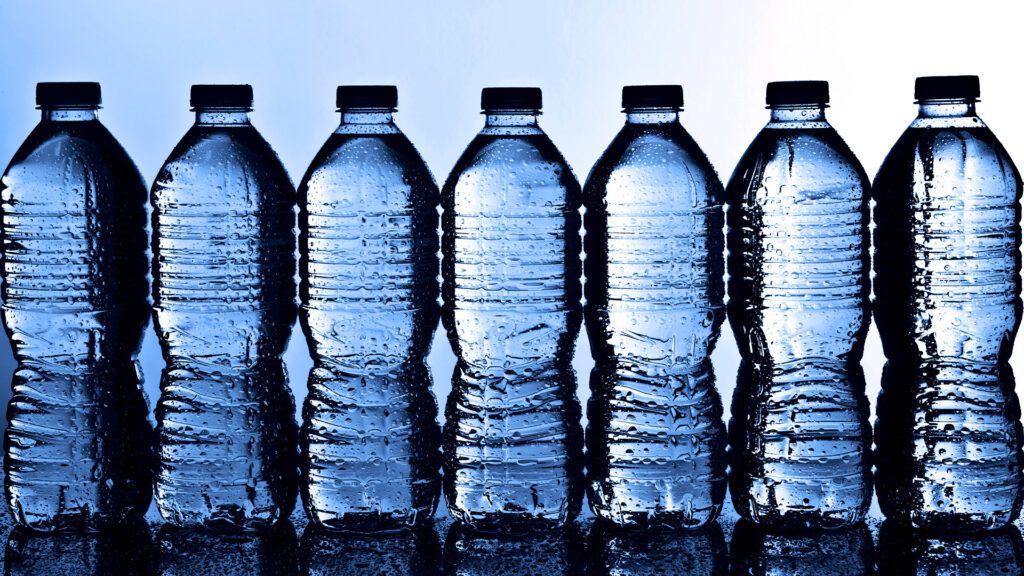
- According to a new study, bottled water contains hundreds of thousands of tiny plastic nanoparticles.
- With the health effects of ingested plastics remaining unclear but worrying, the study suggests a far larger problem than previously understood.
- Similarly, a second new report finds far greater microplastic levels than expected in nearly every food tested.
A new study introduces a new method of detecting tiny nanoparticles — less than a thousandth the width of a human hair — of plastic in bottled water. They are so small that they are measured in billionths of a meter.
Closely following new research from Consumer Reports’ lab that found microplastics — from five millimeters to one micrometer in size — in 84 out of 85 foods tested, plastics seem to have infiltrated the human food chain to an even greater degree than previously understood.
In another recent study from researchers at Columbia University using the new nanoplastic detection method, researchers revealed 10 to 100 times more nanoplastics in bottled water than had previously been documented.
The health effects of this plastic are complex and unclear.
The new study found between 110,000 and 370,000 nanoparticles, most of which were nanoplastics, when they tested three popular bottled water brands.
Using hyperspectral stimulated Raman scattering (SRS) microscopy, the researchers could observe particles as small as 100 nanometers in the water they examined.
The study is published in PNAS.
Dr. Sara Benedé, of the Spanish National Research Council’s Institute of Food Science Research, who was not involved in the study, said:
“Since all methods have limitations, and it is not possible to achieve a method that completely covers the detection of the great diversity of micro and nanoparticles found in the environment, any progress made in the development of methodologies that allow the detection of these particles is positive for the advancement of this field.”
Study co-author Dr. Phoebe Stapleton, in collaboration with study co-author Dr. Beizhan Yan, pointed out:
“Our instrument was tuned to detect plastics only, so we only know that there are other nanoparticles not included in the seven major types of plastics we focused on.
For bottled water, these particles may also come from the filters used in the filtration process.”
– Dr. Beizhan Yan
While the study declines to specify the brands tested, Dr. Stapleton noted, in any event, that, “There was a range in the number of particles that were identified per brand. However, these were still within the hundreds of thousands of nanoplastic particles.”
It is not entirely certain what risks may result from the consumption of such particles. However, research suggests cause for concern.
Dr. Benedé explained, “On the one hand, these plastic particles can cause physical injury by damaging, for example, the intestine when consuming contaminated food, or the lungs when we inhale them.” She attributed this potential harm to “the simple fact that plastics rub against tissue.”
Moreover, she said, “Micro and nanoplastics can also be a chemical hazard, as they contain additives which are added during their production to give them special properties such as strength, flexibility, stiffness, adaptability to external factors, etc.”
Some of the most studied additives, said Dr. Benedé, “are phthalates and bisphenol A [BPA]. Both are considered endocrine disruptors and can alter endocrine system functions leading to adverse developmental, reproductive, neurological, and immune effects.”
Tiny plastic particles may also harbor unhealthful stowaways, said Dr. Benedé. “[Microparticles and nanoparticles] have the ability to bind all kinds of compounds when they come into contact with fluids, thus acting as carriers of all kinds of substances including environmental pollutants, toxins, antibiotics, or microorganisms.”
“Once inside the cells, [the nanoparticles] could release the compounds, leading to additional health issues.”
– Dr. Stapleton
“Plastic particles are not homogeneous,” said. Dr. Benedé. “Depending on the plastic material they come from, their size and also their shape, they will have different effects on our organism, and the hazardous effects can be very diverse.”
“Plastic particles could induce physical stress and damage, apoptosis, necrosis, inflammation, oxidative stress and immune responses, which could contribute to the development of diseases such as cancer, metabolic disorders, and neurodevelopmental conditions, among others.”
– Dr. Benedé
It is also the case that plastics do not readily biodegrade, so once they are ingested, they may remain for an undetermined length of time, potentially posing a long-term health hazard.
The Consumer Reports study found phthalates “in almost every food we tested, often at high levels.”
No single particular type of food was more likely to contain phthalates than another, nor did packaging type appear to be a factor.
The only tested food that contained no phthalates was Polar raspberry lime seltzer.
None of the foods tested by Consumer Reports contained levels of phthalates that exceeded the current safety standards, but those standards do not necessarily reflect the latest medical knowledge, according to the report. It cites Dr. Ami Zota, an associate professor of environmental health sciences at the Columbia University Mailman School of Public Health in New York City, who asserted that allowing such chemicals in food “is not evidence-based.”
Consumer Reports also found substantial amounts of BPA, though mostly at lower levels than their previous study in 2009.
“Highly processed foods and beverages would be more likely to contain plastic particles,” she noted.
“The best advice is awareness and avoidance,” said Dr. Stapleton.
Dr. Stapleton recommended switching from disposable plastic bottles to metal or glass. This provides two benefits. In addition to reducing the risk of exposure to plastics, reusable drinking containers lower the number of bottles used, reducing one’s waste stream.
Dr. Benedé also suggested one “go loose-leaf instead of using tea bags,” rely more on tap water with a filter capable of removing particles, and use a glass container when microwaving.
Dr. Stapleton noted, that despite her study’s findings, “Staying hydrated is crucial for health. Therefore, we do not advise against drinking bottled water when necessary, as the risk of dehydration may outweigh the potential impacts of nanoplastics exposure.”


